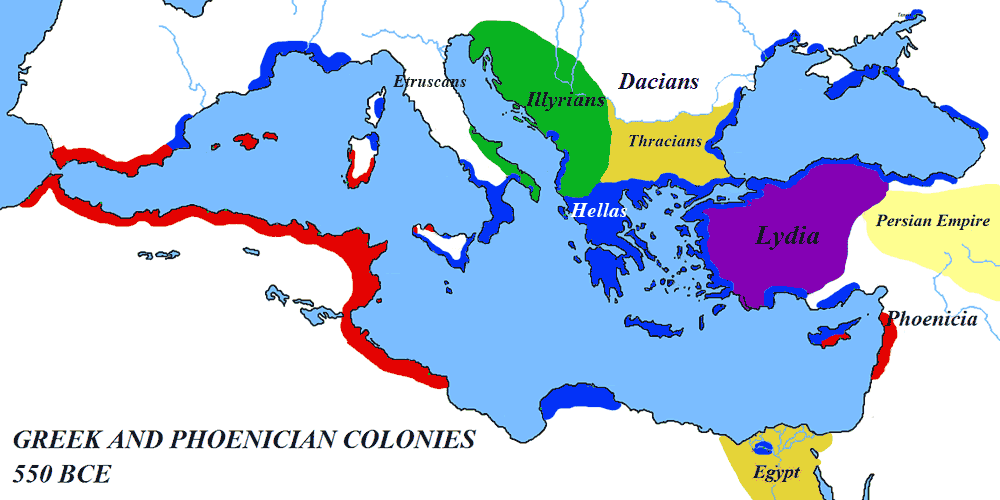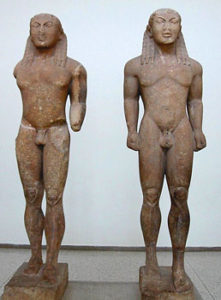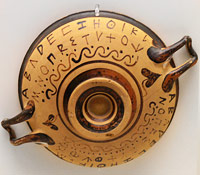
Archaic Greece:
Emerging from the Dark Age 800–500 BCE
Statis or conflict was a continuous and ever-present condition in the steps towards the polis or city-state—the political community which would become characteristic of Greece.
By 900 BCE, Greek society was gradually re-establishing itself, structured around a smaller social unit called an Oikos, each dominated by the head of the household or clan, and housing his family, servants, retainers, slaves and livestock. Eventually these Oikoi expanded into villages and towns. With their expansion came the problem of who was in charge.
Fertile land was limited in Greece, which was, for the most part, mountainous and rocky, and this added to the feeling of stress during these chaotic times. A new type of agriculture emerged with fiercely independent farmers developing less desirable lands with a mixed agriculture, better adapted to conditions than the more centralized agriculture of the aristocratic estates. These farmers would collectively play a pivotal role in the formation of the new Greek society.

Colonization became a safety valve. From approximately 1000 BCE onwards, young Greeks were sent to colonize territories in order to acquire rich, fertile land. In addition, Greeks established trade routes where they sailed looking for resources, and colonies were eventually established at various coastal points, not only around the Aegean, but around the Black Sea and the western Mediterranean, as far as Massilia (Marseilles) in southern France, Emporiae in Spain, Cyrene in Northern Africa, and Olbia—“wealthy”—in southern Ukraine.
One document gives us insight into the Greeks’ motivation to colonize: In Homer’s Odyssey, Odysseus relates his adventures and tells of visiting the Cyclops and gouging out his eye:
– the passage includes the description in the quote that opens this article.
“From there we sailed with heavy hearts, and came to the land of the Cyclopes, a lawless, aggressive people, who never lift their hands to plant or plough, but rely on the immortal gods.… The Cyclopes have no council meetings, no code of law, but live in echoing caves on the mountain slopes; and each man lays down the law to his wives and children, and disregards his neighbours.”
Book IX, Homer’s The Odyssey
He describes what it was like to visit Cyclops’s land. The territory was lawless, run by barbaric people with no sense of community no ágora—meeting place. Each man had a separate law for his own family. But just offshore was the most glorious island just crying out to be colonized and used, and only goats occupied it. “For this island is by no means poor, but would carry any crop in due season. There are rich well-watered meadows there, along the shore of the grey sea, where vines would never fail. There is level land for the plough with soil so rich they could reap a dense harvest in season.”
The audiences of this Homeric poem may well have thought how wonderful it would be to go to that rich land.
The Greeks were influenced by those cultures with which they came in contact, and to these influences they added their own innovations and improvements. Egyptian influence can be seen in Greek architecture and sculpture, yet Greek pillars are more slender and have more graceful lines; their statues are more life-like than the stiff, formal Egyptian models.

The Charioteer of Delphi, Delphi Archaeological Museum. One of the greatest surviving works of Greek sculpture, dating from about 470 BCE Part of a larger group of statuary given to the Sanctuary of Apollo at Delphi by Polyzalos, brother of the tyrant of Syracuse, this bronze in the Early Classical style is one of the few Greek statues to retain its inlaid glass eyes.

Kleobis and Biton, kouroi of the Archaic period, ca 580 BCE Held at the Delphi Archaeological Museum.

From the Phoenicians, the Greeks took the written pictograms of words like alef and bet that meant “ox” and “house” and simply kept the sound: alef (alpha) = the sound A, bet (beta) = the sound B, etc. Thus, in 725 BCE when writing comes back to the Greeks, it is no longer Linear B of the Greek Mycenaean period, but what we now know as the “alphabet.” This was probably one of the greatest developments that contributed to modern thinking. For the first time in history the elements of writing were decoupled from their meaning, so that using only 24–27 phonetic letters combined into any number of meaningful units, the Greeks were able to write about everything they saw, experienced and thought of in their own language.
External Stories and Videos


Watch: Secrets Of The Aegean Apocalypse
Watch: Secrets Of The Aegean Apocalypse
Around 1,200 BC, an ancient Armageddon destroyed nearly every known civilization. What could have caused it? The theories are many, but most now include one mysterious and massively destructive factor – a force only the Egyptians survived to name: The Sea People.
